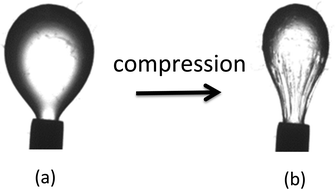Films of bacteria at interfaces: three stages of behaviour†
Abstract
We report an investigation of the formation of films by bacteria at an oil–water interface using a combination of particle tracking and pendant drop elastometry. The films display a remarkably varied series of dynamical and mechanical properties as they evolve over the course of minutes to hours following the creation of an initially pristine interface. At the earliest stage of formation, which we interrogate using dispersions of colloidal probes, the interface is populated with motile bacteria. Interactions with the bacteria dominate the colloidal motion, and the interface displays canonical features of active matter in a quasi-two-dimensional context. This active stage gives way to a viscoelastic transition, presumably driven by the accumulation at the interface of polysaccharides and surfactants produced by the bacteria, which instill the interface with the hallmarks of soft glassy rheology that we characterize with microrheology. Eventually, the viscoelastic film becomes fully elastic with the capability to support wrinkling upon compression, and we investigate this final stage with the pendant drop measurements. We characterize quantitatively the dynamic and mechanical properties of the films during each of these three stages – active, viscoelastic, and elastic – and comment on their possible significance for the interfacial bacterial colony. This work also brings to the forefront the important role that interfacial mechanics may play in bacterial suspensions with free surfaces.


 Please wait while we load your content...
Please wait while we load your content...